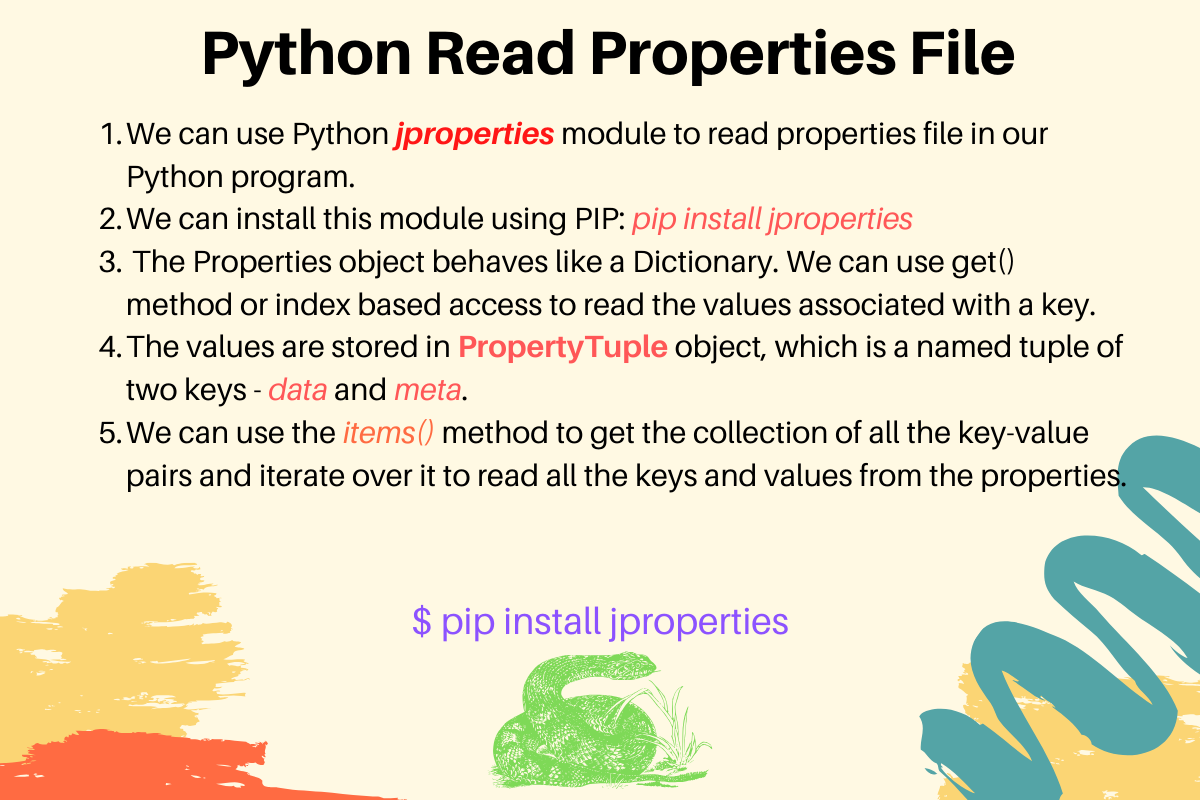- Log in to:
- Community
- DigitalOcean
- Sign up for:
- Community
- DigitalOcean

We can use jproperties module to read properties file in Python. A properties file contains key-value pairs in each line. The equals (=) works as the delimiter between the key and value. A line that starts with # is treated as a comment.
Installing jproperties Library
This module is not part of the standard installation. We can install jproperties module using PIP.
# pip install jproperties
Reading Properties File in Python
I have created a properties file for our example: app-config.properties.
# Database Credentials
DB_HOST=localhost
DB_SCHEMA=Test
DB_User=root
DB_PWD=root@neon
The first step is to import the Properties object into our Python program and instantiate it.
from jproperties import Properties
configs = Properties()
The next step is to load the properties file into our Properties object.
with open('app-config.properties', 'rb') as config_file:
configs.load(config_file)
Recommended Reading: Python with Statement
Now, we can read a specific property using get() method or through the index. The Properties object is very similar to a Python Dictionary.
The value is stored in a PropertyTuple object, which is a named tuple of two values - data and meta. The jproperties support properties metadata too, but we are not interested in that here.
print(configs.get("DB_User"))
# PropertyTuple(data='root', meta={})
print(f'Database User: {configs.get("DB_User").data}')
# Database User: root
print(f'Database Password: {configs["DB_PWD"].data}')
# Database Password: root@neon
We can use len() function to get the count of properties.
print(f'Properties Count: {len(configs)}')
# Properties Count: 4
What if the key doesn’t exist?
If the key doesn’t exist, the get() method will return None.
random_value = configs.get("Random_Key")
print(random_value) # None
But, if we use the index then KeyError is raised. In that case, it’s better to handle this exception using try-except block.
try:
random_value = configs["Random_Key"]
print(random_value)
except KeyError as ke:
print(f'{ke}, lookup key was "Random_Key"')
# Output:
# 'Key not found', lookup key was "Random_Key"
Printing All the Properties
We can use the items() method to get a collection of Tuple, which contains keys and corresponding PropertyTuple values.
items_view = configs.items()
print(type(items_view))
for item in items_view:
print(item)
Output:
<class 'collections.abc.ItemsView'>
('DB_HOST', PropertyTuple(data='localhost', meta={}))
('DB_SCHEMA', PropertyTuple(data='Test', meta={}))
('DB_User', PropertyTuple(data='root', meta={}))
('DB_PWD', PropertyTuple(data='root@neon', meta={}))
Since we are looking to print key=value as the output, we can use the following code.
for item in items_view:
print(item[0], '=', item[1].data)
Output:
DB_HOST = localhost
DB_SCHEMA = Test
DB_User = root
DB_PWD = root@neon
Getting List of Keys from the Properties File
Here is a complete program to read the properties file and create a list of all the keys.
from jproperties import Properties
configs = Properties()
with open('app-config.properties', 'rb') as config_file:
configs.load(config_file)
items_view = configs.items()
list_keys = []
for item in items_view:
list_keys.append(item[0])
print(list_keys)
# ['DB_HOST', 'DB_SCHEMA', 'DB_User', 'DB_PWD']
Python Read Properties File into Dictionary
A properties file is the same as a dictionary. So, it’s a common practice to read the properties file into a dictionary. The steps are similar to above, except for the change in the iteration code to add the elements to a dictionary.
db_configs_dict = {}
for item in items_view:
db_configs_dict[item[0]] = item[1].data
print(db_configs_dict)
# {'DB_HOST': 'localhost', 'DB_SCHEMA': 'Test', 'DB_User': 'root', 'DB_PWD': 'root@neon'}
Reference: PyPI jproperties page
Thanks for learning with the DigitalOcean Community. Check out our offerings for compute, storage, networking, and managed databases.
About the author
Java and Python Developer for 20+ years, Open Source Enthusiast, Founder of https://www.askpython.com/, https://www.linuxfordevices.com/, and JournalDev.com (acquired by DigitalOcean). Passionate about writing technical articles and sharing knowledge with others. Love Java, Python, Unix and related technologies. Follow my X @PankajWebDev
Still looking for an answer?
this library doesn’t support multiline string value in properties file.
- ishwor
- Table of contents
- Installing jproperties Library
- Reading Properties File in Python
- What if the key doesn't exist?
- Printing All the Properties
- Getting List of Keys from the Properties File
- Python Read Properties File into Dictionary
Deploy on DigitalOcean
Click below to sign up for DigitalOcean's virtual machines, Databases, and AIML products.
Become a contributor for community
Get paid to write technical tutorials and select a tech-focused charity to receive a matching donation.
DigitalOcean Documentation
Full documentation for every DigitalOcean product.
Resources for startups and SMBs
The Wave has everything you need to know about building a business, from raising funding to marketing your product.
Get our newsletter
Stay up to date by signing up for DigitalOcean’s Infrastructure as a Newsletter.
New accounts only. By submitting your email you agree to our Privacy Policy
The developer cloud
Scale up as you grow — whether you're running one virtual machine or ten thousand.
Get started for free
Sign up and get $200 in credit for your first 60 days with DigitalOcean.*
*This promotional offer applies to new accounts only.
